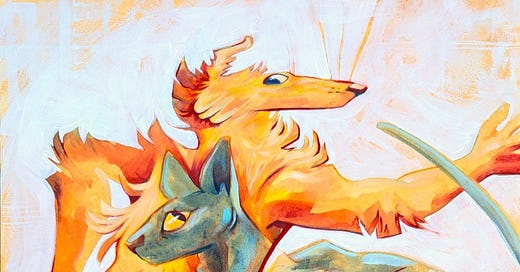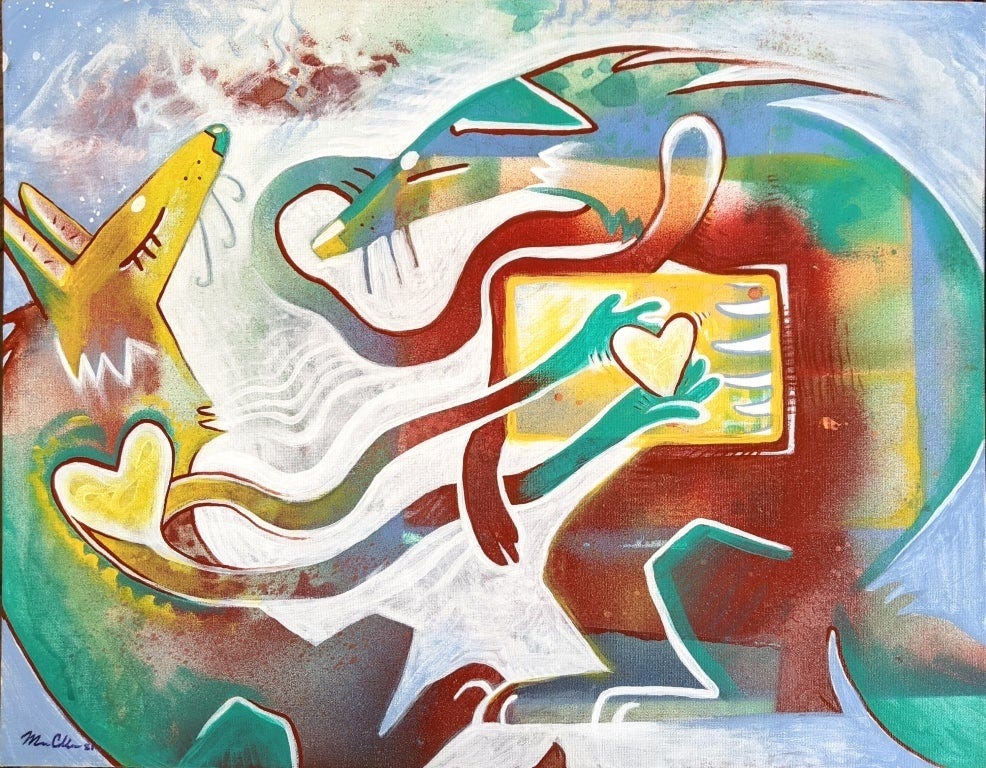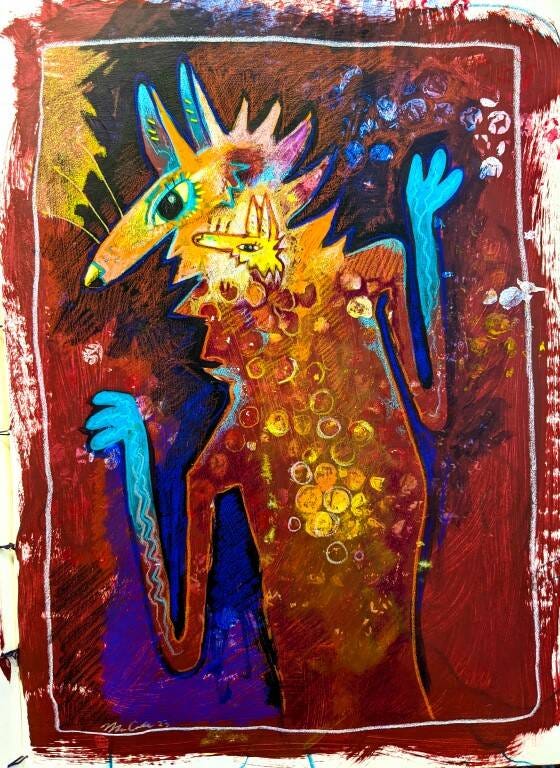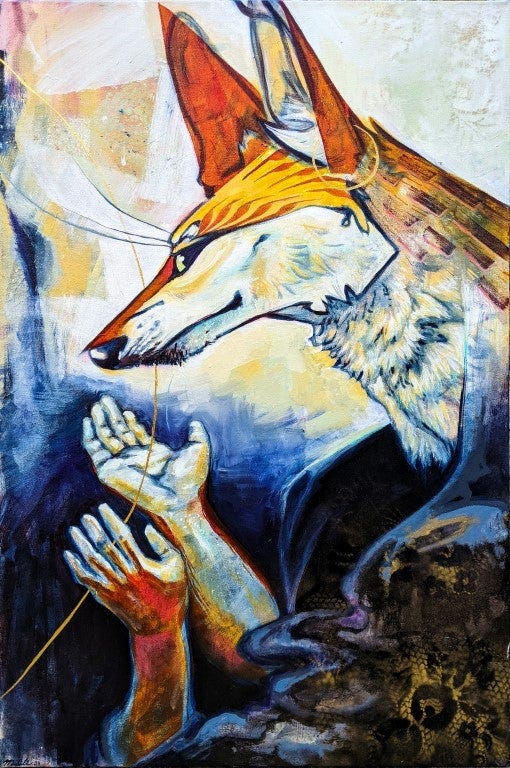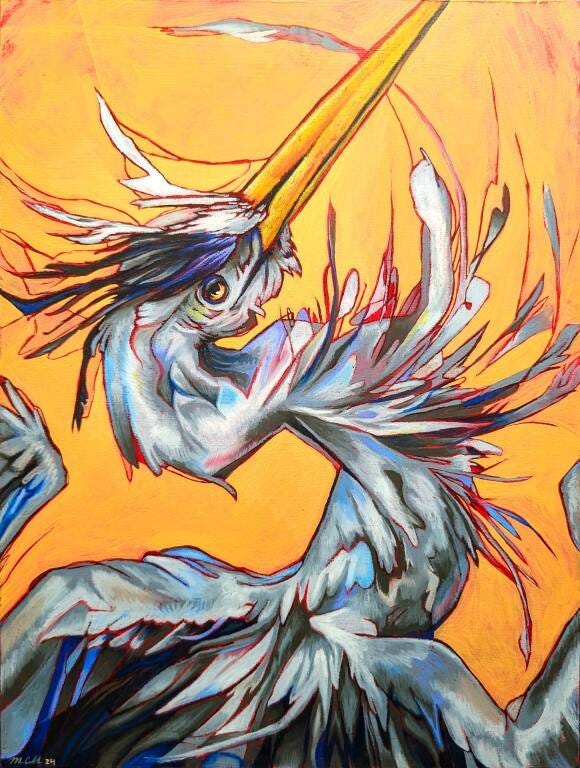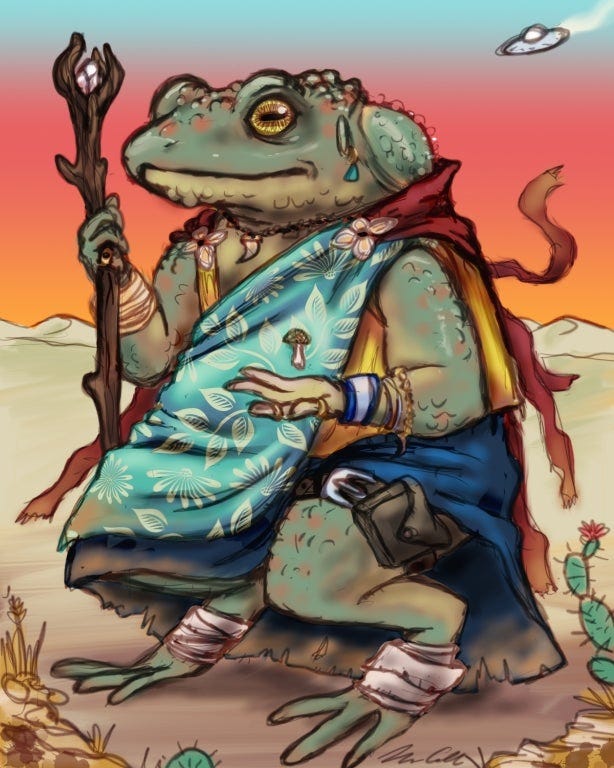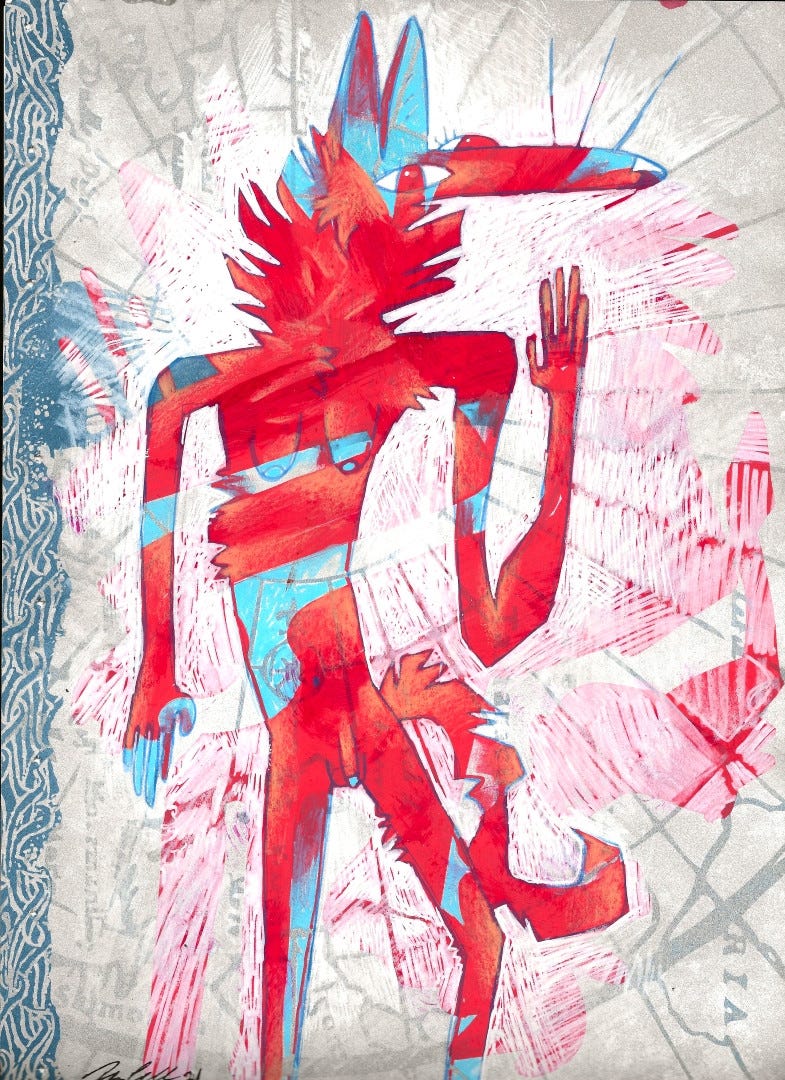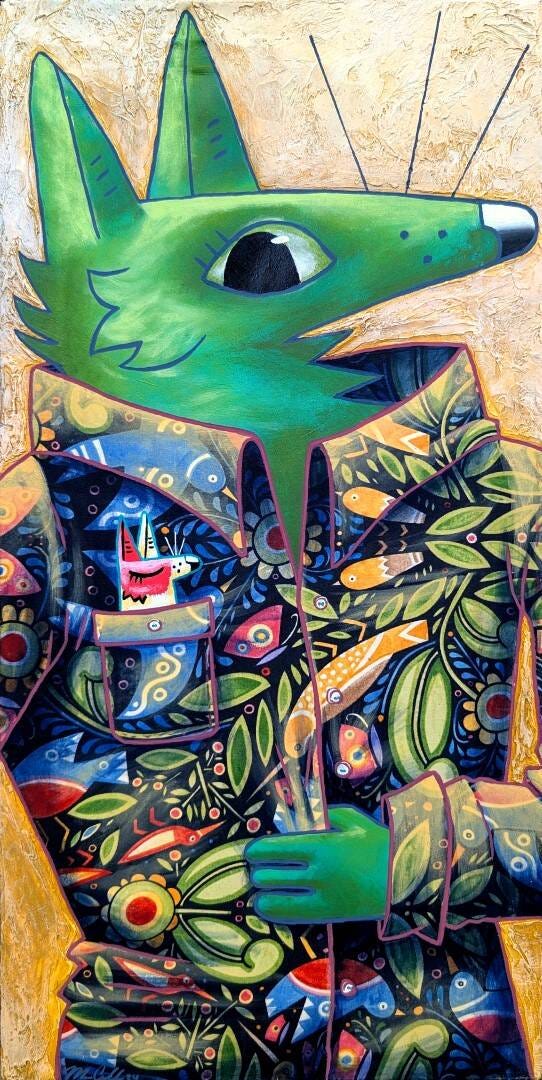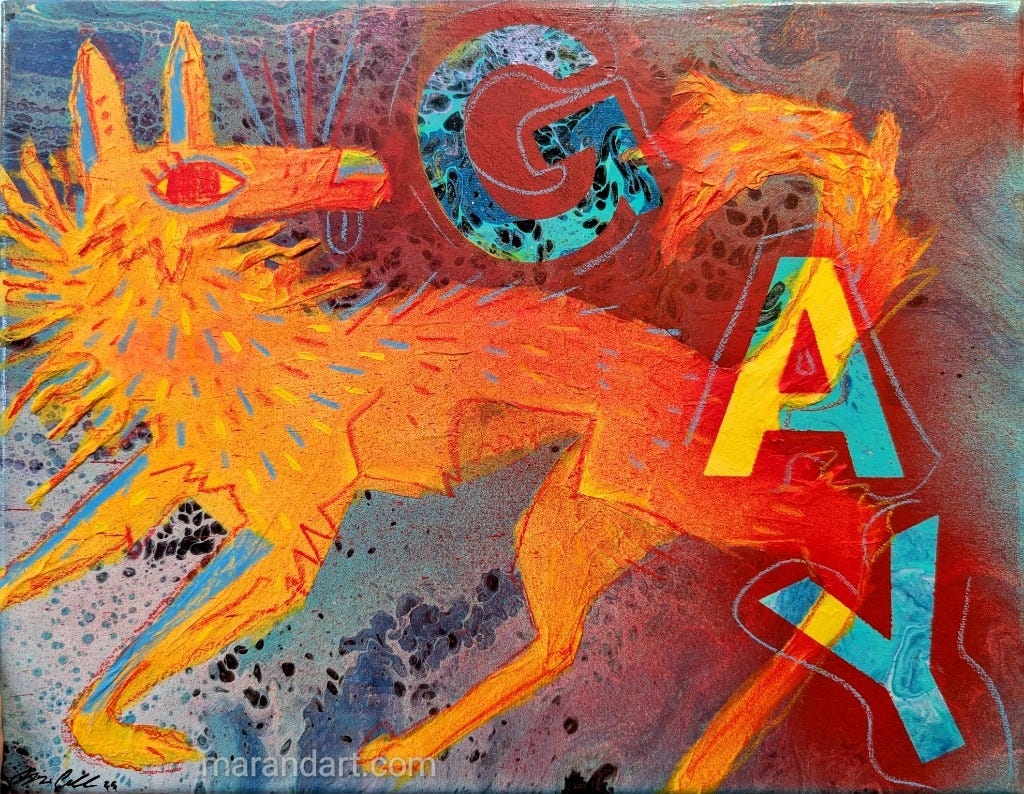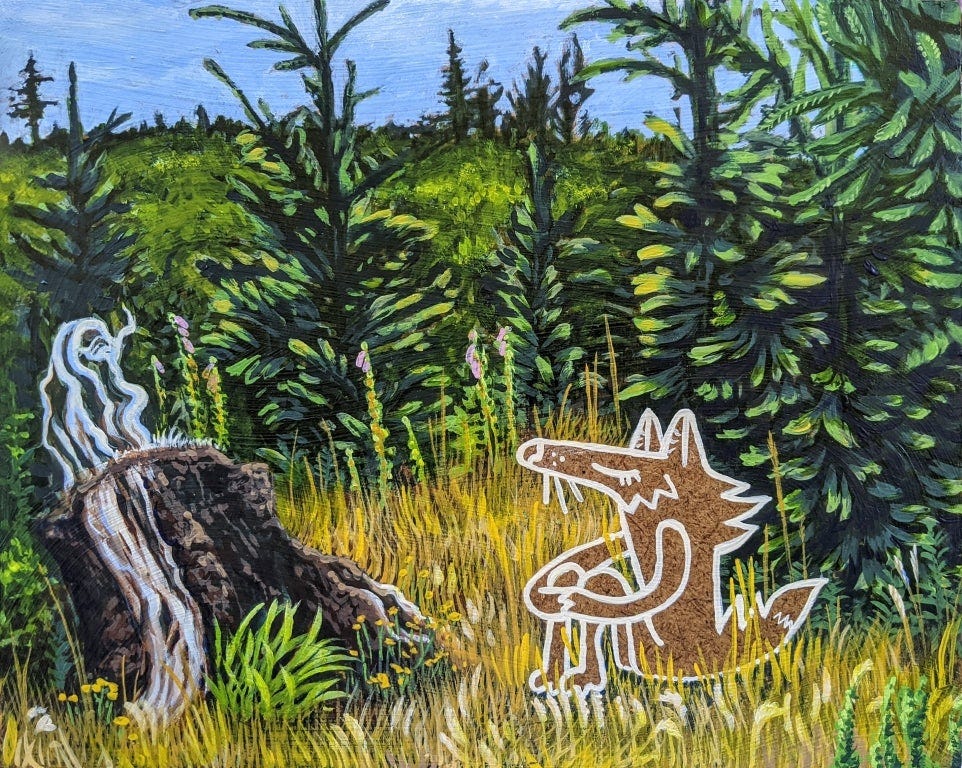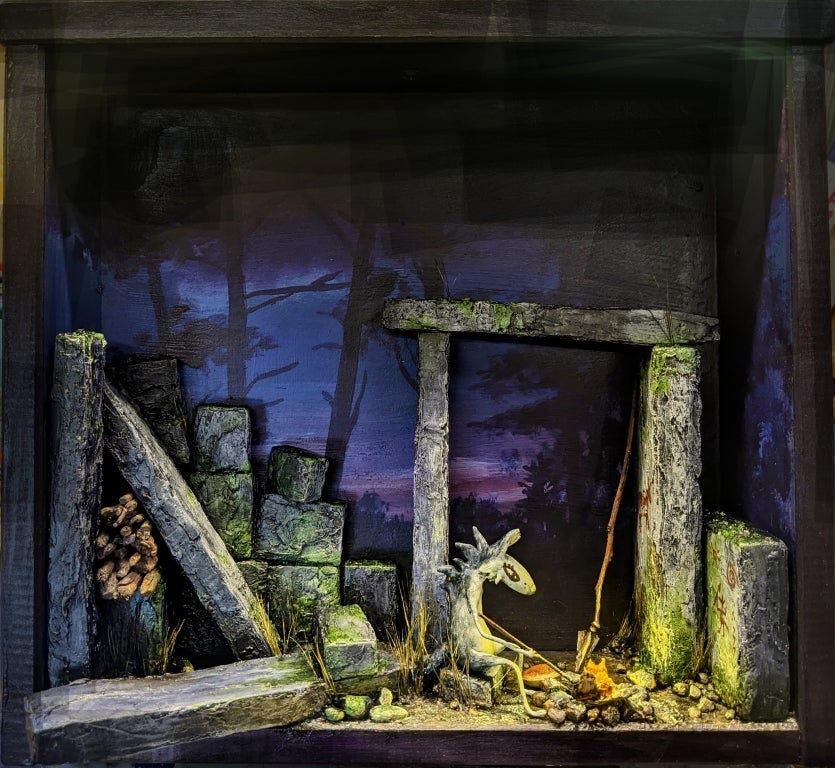Here is my interview transcript with Maranda Cromwell (agender, any pronouns), please enjoy and check out their work!
If you’re an artist and you would like to be interviewed, then please reach out! I may not be able to respond to everyone, but I’ll take you into consideration.
www.marandart.com, https://bsky.app/profile/marandart.bsky.social
Ripple: Hello, welcome! Hello… Marandart? Or is it Maranda Art?
Marandart: Both. Yeah, I just go by Maranda Art more.
Ripple: Yeah, I thought it was kind of interesting you combined “Art” and “Maranda” together.
Marandart: Yeah, it's a really old username. But I've had the URL for many, many years, and it's become my username for so many places. It’s how people can find me now, so it's one of those like, “Oh, I made the email when I was 14 and now I'm stuck with it,” kind of scenarios.
Ripple: Speaking of that, could you give a little introduction and say a little bit about where people can find you online?
Marandart: Sure, my name is Maranda Cromwell, or just Mar. I'm usually Marandart online. My website is www.marandart.com, and I am all over the internet. I have a Bluesky, Tumblr, Instagram, YouTube... I do process videos of my mixed media art practice, I do a lot of printmaking, I'm a full-time independent fine artist with my partner Echo who is also a full-time independent artist and we have a small farm in western Washington.
Ripple: Wonderful! There's a lot that you do and I'm very interested in the mediums of what you're doing. Because like you mentioned, you do a lot of mixed media stuff.
Marandart: Yeah, I would say my top three materials at this point are probably acrylic paints, paint pens (which is just a type of acrylic paint, really, but in a pen form), and wax pastels. Those are my three go-to guys. I typically do fluid acrylics nine times out of ten, there's almost never an instance in which I don't use them. It's my mainstay. It feels kind of like the bread of the sandwich of the mixed media piece. Like, it's not really a sandwich if it's not the acrylic paint. I don't really do oils, the drying time is challenging because I live in a humid environment and also I have a lot of furred animals in the house and so I just know that it would be covered in fur. So I like the fast drying guys, I like the fast drying water-based media, that's my jam. And there's a lot of considerations with oil paint, there's a lot of rules. I learned how to do it in college. I'm glad that I got to try it and decide that I didn't like it instead of buying a bunch of stuff and then figuring out the hard way.
Ripple: That's completely fair. And you know, I did the reverse with acrylic paint. I don't like it very much but I bought a whole lot of it.
Marandart: Oh no! Maybe you can find someone who could put it to use if you're not into it.
Ripple: Yeah, I gotta double check that it's still in good condition because some of it may have dried out or just aged badly or something.
Marandart: Depending on the brands, yeah. The better the brand, the less of that you'll find. So it kind of just depends on the quality of the acrylic media and the mixing and if they have any additives that they've added to it... Yeah, paint chemistry is wild, I only just know just a teeny tiny bit of it but it's insanely complicated.
Ripple: It's very cool for sure. So, to begin talking about some specific artworks a little bit... I'm going to send a little bit over here... Oh no, it says that the file is too big…
Marandart: Oh no, too powerful…
Ripple: Too powerful! Go with the next one!
Marandart: Oh, Being There, yeah.
Ripple: Yeah, I'm looking at the Primitive Wiggles section on your website and I feel like it has a very good descriptive title because you make the limbs and everything else very wiggly, very sort of jointless. They're noodled a little bit. Like they can squiggle their arms in whatever way they want.
Marandart: Exactly, they can do anything, they can fit any composition I need them to, no rules just right.
Ripple: Mhm, and I love seeing that playfulness and that sort of flexibility with the kinds of things you're doing. At the same time, it's very interesting because you’re doing things that are somewhat inspired by cave paintings. I think some of how that shows up is with the side angles on most of the characters' heads, because it just feels like that's the sort of ideal form, if you will, of how people recognize animals. Like, if you were to draw out a symbol, that's how it would normally turn out, and so I feel like there's this interesting combination between the more firm, more symbolic sort of side of what you're doing with the squiggly, playful, open side of it.
Marandart: Yeah! I like to think of my style as kind of a hybridization of... Well, the Primitive Wiggles series I developed intentionally in 2020, so I actually haven't been using it for a long time when you consider my entire art career. So I decided to switch to that, like you said, very simplified style. I was trying to find the essence of the creatures that I'm creating, just taking that simplification and then pushing it harder and harder. I’m figuring out: what is the absolute essence of this creature? Then finding those traits and enhancing them. So it's a little bit like cartooning, it's a little bit like graphic pop art, it's a little bit, you know, like Keith Haring. With the experimental mixed media aspect, that really comes from a sense of play and exploration (which I consider to be a very important thing in art), so it was a very deliberate reframing of how art is for me and how I do it. So yeah, the Primitive Wiggles are quite meaningful to me and they encourage a lot of freedom.
Ripple: I think that's a very modernist thing to try and find an essence, to try and find the most simplified form of something. What do you think of that in terms of what you're doing art historically, or where do you see that fitting in today? Because I feel like when you talk about finding the essence, finding the “primitive” side of things, it falls much more in line with the ideas from before postmodernism where you can find universal narratives or ideas that can be more grounding, whereas postmodernism really questions those things. Postmodernism says that you can't find truths, or that if you do find them they're all individual. Like, you can't have ideas be shared very easily all the time. Maybe it's an odd question, but where do you see your art in terms of that kind of conversation?
Marandart: Oh shucks, that's a big question. I mean, my mind immediately thinks of more highbrow kind of gallery scene definitions of art in that way. What furry is and what I am doing, which is a little furry and a little not, it’s sort of outside of that realm. It's funny because I'm not technically an outsider artist because I did go to college for art, but I am an outsider artist in that I am not behaving in the way that my instructors thought that graduates might, which is to move to the city, rub elbows with gallery owners, and eventually get your work in a show, which I was not into. I do not like living in the city and I do not like rubbing elbows with people who I do not respect, so this is a much better scene for me. But I would say it's really hard to see your place in history when you're [living] it.
Ripple: That's true.
Marandart: But if I had to say anything, I mean, I really hope that furry is becoming kind of like an art movement. I've been seeing more and more consideration and meaning and thought and stylization and contextualization in history happening in furry lately which is so cool to see, and there's so much radical authenticity going on without a regard for what is good or sellable or “in” at the moment, you know? It seems very countercultural in a way that I think a lot of artists historically have been, so I don't know! It's my hope that one day in 50 years someone will, you know, crack open their tablet textbook and their little AI assistant will be reading it to them and it'll be like, “The furries in the early 2000s...” I can envision that, I think it would be kind of funny and very cool. Furry is growing a lot and it's becoming less and less of a bullyable trait to have, which is a huge paradigm shift from when I was in high school.
Ripple: Right, right, for sure, and I love what you're saying with that because I do feel like it's a realm in which people are able to experiment and express themselves in a very distinct way. There's a strong theme of the animal characters and everything but it's also a very open kind of fandom. Or if you want to go so far as to call it a movement for art, it's a very open kind of thing for how you do that.
Marandart: Oh yeah, very nebulous, and it means something different to each person.
Ripple: Yeah. So there's a focus on both just the animals and maybe our relationship to animals, and also just self-expression, which is a very interesting kind of combination. I think depending on how you do it, it could touch on environmental concerns and things like that, and at the very least increase empathy for animals that live around you. And it can also just be this place for you to escape or try to do things in a fun and different way than you're used to.
Marandart: Yeah, I think furry is so... It has such a strong track record because it is so independent and made by the people who want it to exist. I think that's a huge, huge facet of furry culture: we make it and it's for us, which is cool. I love that we can find connection with each other through the middleman of animals. For a lot of furries, we're a little socially weird. I'm speaking from my experience, mostly, I'm a little weird. You know, growing up—
Ripple: I’m a little weird.
Marandart: Yeah, I think we're all just little weirdos. And I mean that super affectionately because you're my people. That method of finding connection with people through the shared love of an alter ego or a self-made image, a character or a cartoon character. Certainly, some furries are not super into animals. I've noticed they're not into biology or anything like that, they're more just—I don't want to call it escapism—but it is like they're seeking a place where they can be authentic and that means that they get to choose what they look like, which is a huge huge part of furry.
Ripple: And I think to speak for myself a little bit, I think I'd fall more on the side of—funnily enough I'm not very well connected with animals. I have pet allergies, and I avoid pets most of the time.
Marandart: Oh… Yeah.
Ripple: But it's like I feel drawn to the creativity that I see, the self-expression, and things like that. It's like there's something to find in it either way, you know?
Marandart: Yeah, I find that people are drawn to furry for a lot of different reasons and it's really fascinating to see the different reasons why. I attract a lot of the punks, the fine art appreciators, and the biology nerds and that's great, I love that. But I know a ton of furries who didn't get into it because of the animal aspect, they got into it because of the... Well, I think it's just easier to relate to another creature that's not a human being. Human beings have so much baggage. Animals are such a safe middle ground because they have similar emotional expressions, especially mammals, and canines. We have such a historical connection—we've been with dogs for 30,000 years. There's no coincidence that furries are, you know, huskies and foxes and stuff like that. It's because that animal is the easiest to connect with and the easiest to relate to.
Ripple: It's kind of like the animals are safer in some way. We're more afraid of each other as humans than we are of animals in most circumstances.
Marandart: Yeah, it's like those comics where it's like, "Oh, catch me petting the dog at the party instead of talking to people." And animals have a remarkable healing capability for folks who have trauma or social anxiety, they're a fantastic and super important part of human life, I think. Whether or not you directly interact with them—oh gosh, yeah, I could go on and on.
Ripple: Yeah, I was going to say, you know, I think as someone who's running a homestead and everything, you're doing some farming and stuff, I feel you must have come to furry art more from the position of liking animals quite a lot. Would you say that's true?
Marandart: I would say that's definitely true, yeah. Well, originally, in high school I was definitely that kid that was like, “I'm not a furry I'm just into anthropomorphic characters,” you know, to protect myself from the bullies and because I couldn't be authentic with myself out of fear. High schooler problems, yay! But yeah, definitely, my fixation from day one on Earth has been animals. A dog was the first thing that I laughed at organically without being prompted to by my parents. It was the first thing I saw in the world and thought, “that thing rules.” So yeah, it's been a huge part of my life for pretty much my entire life. I worked pet retail for, like, 10 years before I went freelance and I pretty much am always surrounded by animals. I find that my mental health is extremely benefited by a wealth of animals to be enriched by, so I do feel extremely grateful and lucky to have what I have, to have the availability to interact with so many critters.
Ripple: It sounds really wonderful. I guess my equivalent would be that I need to stare at trees more often, you know? I need to be outside.
Marandart: I think everybody could do that more.
Ripple: I like going camping every so often, not for long periods of time, but I like hiking. That's what I’ve got to do since I can't reasonably have pets, really...
Marandart: Oh yeah. Well, there's so many other ways, there's so many other ways you can be enriched by the wildlife around you. And you being in Utah, you've got all sorts of really cool trails and stuff, I've always wanted to see Arches and stuff like that. Gorgeous, gorgeous country.
Ripple: It’s quite wonderful in some places!
Marandart: Yeah, really beautiful desert.
Ripple: Yeah. To look a little bit more at some of these pictures... I have one question, also: on your website, the pictures that I'm looking at don't seem to have titles on top of them. Are these pieces untitled or are they just not labeled?
Marandart: It's a limitation of the website builder that I use. It's not my favorite, but it's tied to my online shop so I'm just kind of doing what I can. I separate them into two categories of general themes. I have my more animal-specific artwork such as the heron series which is an experiment on style and bird shapes. And the coyote in the shawl with the hands that you just sent, that's called The Guide III, I have a long ongoing series of cloaked canine figures who I paint every now and again. I just have this bug in me. They usually come out after I haven't made art for a long time and so the Guide emerges and helps guide me into art.
Ripple: Yeah, yeah.
Marandart: Exactly. So there's three of them, all of them are in private collections and I have kept the first one. Yeah, the first one was a collaboration between me and my partner, actually. I like to keep a lot of our collaborations just because it's fun to make art with someone you love.
Ripple: Oh of course, yeah, and are these more recent or are they older? I can't really tell that chronology, either.
Marandart: The gallery on my website is a curated list, so it is art through the ages. There's not a ton of really old stuff. The Primitive Wiggles, like I said, started in 2020, so they're not any older than the Animal Teachers section. I think the toad actually might be the oldest one… Terence the Toad, that's the only digital piece of artwork I have displayed on my website, actually. It's the last digital piece that I did.
Ripple: Nice, nice. Did you test out doing digital art and then decide to not do it? It didn't feel right, or something?
Marandart: I actually started out extremely passionate about digital art. So, when I first got into art I was like 10 years old. I was really into Neopets and Pokemon and, you know, little Game Boy games and stuff. So that really inspired me to start drawing. And I was a dragon kid. I'd draw dragons on everything. And that was usually just pencils and markers, right? Because I was a little kid and things like Photoshop were still about $600—an exorbitant amount. It was a professional art tool that you can't just access as a young person. So my passion was to get digital art programs. Oh, I wanted it so bad! I would use stuff like Open Canvas 1.1, I don’t know if you’ve ever heard of that...?
Ripple: No, actually.
Marandart: It's an art program that's small enough to fit on a floppy disc.
Ripple: Oh, nice!
Marandart: Yeah, it's a baby. I think it just had color picking, no layers, a smudge tool... basic. So I would make a lot of art with that, and eventually I got Corel Painter. I got Corel Painter X and that ran on my laptop for as long as Corel supported it, which was about 10 years. Then as soon as Corel was like, "Oh this art program that you've used for a decade, sorry, you have to buy a new one, now they're $700." And I'm just like, "Okay, well, I guess I won't do that." And then I experimented with getting some Surface Pro tablets that are just like a laptop that have the tablet surface that you can draw on, and I would use Autodesk Sketchbook and really basic little programs ‘cause I just don't like to have to learn all the freaking menus. I don't know Photoshop. It’s just got too many options. I think digital art gives you too many options and it overwhelms me. So I shifted back to traditional art as my tablets kept bricking. I kept trying to shrink the availability I had to make digital art and then I realized that I just needed to do traditional. When I went to college I started making the shift really hard because a lot of the classes that I was taking were about physical media. I was taking fine art classes so there weren't a lot of opportunities to do digital illustration. I did a few in some of the design classes, but yeah, I made the pivot to traditional art just because I found it so much more tactilely satisfying, and I just became frustrated over time with freaking technology, you know? It's like, companies are not your friend, and an art supply that you have on your shelf is not going to suddenly turn into a subscription.
Ripple: Yeah, you just have to buy more if you run out.
Marandart: Yeah, that's just a consequence of living in a physical reality.
Ripple: I get what you're saying, I definitely relate to the overabundance of menus, settings, and so on. It's a bit much when I try to do anything digital.
Marandart: It's a learned skill, you know, it takes a long time to intuit it. The menus, and to find your favorite tools... I really respect digital artists who know what the hell they're doing! Not my realm, but, you know, it's impressive.
Ripple: Yeah, it's just a lot more natural and a lot more intuitive if you're doing physical media, I think, because the settings are like... How hard you press down onto a piece of paper or something like that. So you kind of know how to control things even if you don't have a good handle on it yet, so it's a different kind of learning process.
Marandart: Absolutely, and I find the tactile feedback to be super rewarding, too, because it makes you better at a lot of other things. I've noticed my hands are steadier and my body hurts a lot less now that I am standing at an easel and drawing on a surface with my whole body, you know? You use your whole arm to get a really good gesture. I would need the biggest tablet in the world to do that and that's a mortgage payment!
Ripple: Yeah, yeah, that’s a lot!
Marandart: And with the tablets, too, if something goes wrong, then you have to become an IT guy to fix it. So I like the autonomy that physical art gives you because it's like, “Oh no, something's not working with my material. Is it dried out? I can add some water to it.” You get to just use common sense to troubleshoot stuff. But if your tablet pen breaks then you're like, "Well I could learn how to fix tablet pens...”
Ripple: “I could get a computer science degree.”
Marandart: Yeah! So I really appreciate the flexibility of traditional art and when I say that people are like, "What?" But it's just what I like.
Ripple: Yeah, I feel that for sure. To pivot just a little bit I want to talk about something that I feel wasn't covered as much in some of the previous interviews that I looked at a little bit in the press coverage that you have on your website. So they talk about the animals, of course. They talk about your thoughts about the environment and stuff like that, but there's also this element of queer characters that's very important. Like in furry stuff especially. So this looks like it's a Trans Day of Visibility piece that you did.
Marandart: Yeah, this one came out of the Trash Book and it was part of an effort to display more obviously trans bodies in my work.
Ripple: Yeah, yeah, so it's that element of representation that's very important where it's showing bodies that are not just the standard thing that you'd get in a textbook if you look at the diagrams of “male and female,” things like that.
Marandart: Yeah. I'm very involved in the trans community, I identify as agender which technically counts. I've not medically transitioned, but many, many—almost all of my friends I feel are queer or trans in some capacity. I often think about my role as an artist in the world. Trans people are getting thrown under the bus because they're the new scapegoat for the regime, so I'm like, "Alright, what can I do as this little guy?" I'm just going to do more blatantly trans bodies in my work. I'm going to let people know where I stand. Look here's a trans person, this is fine. You need to get over this, here, they exist. It's normalizing it, you know?
Ripple: Yeah, you have to have those kinds of things in existence because especially with the Trans Day Visibility, the idea is just that their people aren't being represented in a lot of instances, and it's not being talked about. I think we've reached a point where there are a lot of people who are thankfully making space to talk about trans rights and trans issues, so it has become very recognized. And as time goes on, the goal is that it'll be more normal, more respected in all fields of life.
Marandart: And I think that we'll get there. It seems as if it’s a progression that will continue. Trans people are not going to go away, you know, and when it comes to your identity and feeling safe in your body, that's a pretty compelling reason to fight. I think it's just a matter of history repeating itself. First it was women who wanted more rights because we're sick of this shit, you know? And then it was the gays, and the AIDS epidemic, and becoming visible in that way, and now it's trans people. What will it be in the future? There's always going to be some new thing—according to the people who do not like it, they will see it as a new aberration or something—and they're always going to frame some new human evolution as a threat. That's why I feel like displaying a trans body is important. I also sell a lot of stuff at local street fairs and I live in a pretty rural area in Washington. Not the most rural area, we are about 50/50 blue-red split, but there's definitely some “proud country folk” out here and they have this idea about things. I still have some trans connections a little up north who are being harassed by their neighbors for transphobic reasons. It's a little bit more of a fight in the rural areas where there's less education and less exposure to trans people but even out here I see the people... you know, there's a lot of them working at the hardware store and I kind of make eye contact, I'm like, “I see you.” So there's some camaraderie, absolutely. And some of the local organizations that we volunteer with will use some trans-inclusive language in some of the legislations that they're trying to push, and they'll do pronoun exchanges at the beginning of a meeting and stuff like that, so I see the paradigm shifting in spaces where people care, which is nice to see.
Ripple: Yeah, yeah, absolutely, absolutely.
It's interesting to me—this is kind of maybe an odd observation, you can let me know what you think of it—that you're talking about both the sort of primitive things, old things, and nature, and you're also talking about things that are quite contemporary like trans rights as the discussions surrounding it exist today. Oh, here's another funny example of combining the timelines here. This one's more funny, but you’ve got this...
Marandart: Cool Shirt guy!
Ripple: Yeah, this Cool Shirt guy! There's a combination of returning to the essence of animals, nature, and cave paintings, but there's also an interfacing with [contemporary] things [like the printed shirt design worn here], and like trans rights and representation. It's interesting to be talking about both simultaneously.
Marandart: It is interesting to talk about both simultaneously, it does feel like folding time on itself, the oldest-then and the nowest-now.
Ripple: I think in terms of trans rights, it's interesting because I think trans people are both simultaneously not new and simultaneously kind of new at least in the sense that the awareness has developed a lot in the in recent years, and the language that we have around it, and the technology, even, the medical technology to help people have the bodies and lives that they want to have… So, it's simultaneously new in that way but it's also very old.
Marandart: Oh, yeah.
Ripple: Two Spirit people in Native American culture, for example, have existed for a really long time, you know?
Marandart: Well, even the Christian Bible has a third gender, but people don't know enough about gender theory to really pin it as such. The eunuchs had a very different gender role than other men in that society so that was a third gender. It's extremely interesting to hear about other cultures across the world, pre-colonial cultures in particular. There were matriarchal cultures in the Polynesian islands, there are third genders in some cultures in India. It's a really cool thing. I think that gender as an anthropological aspect of things is simultaneously fascinating to me and also frustrating because I find that the rigidity of gender norms in western cultures are stifling and harmful. That's my belief. I love being agender, I love opting out of this assigned role. I like to behave just how I like to behave. But I guess to answer your question about cave art and contemporary issues, it's a little twofold. So, the contemporary issues are, you know, trans rights and environmentalism and the justice for all people regardless of what class they were born into, and I consider those values to be akin to the cave art aspect of my work because where we're at now is a very individualist culture and I find that to be antithetical to human nature. We really only got to where we're at because of cooperation, and because of understanding each other and working together. I just don't see a lot of that [anymore], and so I try to impart those values into things in my work. The cave art is really just a callback to what makes us human in the first point, because we can all relate to the human desire to paint an animal. That's mostly what they made.
Ripple: Yeah.
Marandart: What we still have is pictures of themselves, pictures of themselves hybridized as animals, and pictures of animals. I think [when it comes to] the motives for cave art, we're not super sure, because there's no written language or any of that, so we really are just kind of guessing. But there is a reason for it—you don't exist in a hunter-gatherer lifestyle with limited resources, make all of your paint, make the pitch to make the torch and the candles so that you can see in the cave [unless you] really want to do that. And that compulsion I really relate to because—
Ripple: I think they were very bored, they must have been—
Marandart: Well it speaks to—
Ripple: They needed a project.
Marandart: Yeah! Well, some people refer to hunter-gatherer societies as the original affluent society because everyone had what they needed, because the Earth provided, it was just available to you. You could just go get food. And you had a long history of finding food, healing each other, and community and togetherness... The strong human ties I think are like—I really want to impart that. Look, we're all human beings, we all just want to paint animals on the wall, I don't know.
Ripple: Mhmm, mhmm.
Marandart: And then, and then! To tie that into the contemporary issues, I find it like a personal responsibility. I find it a personal responsibility to talk about things that I care about. I care about a lot of stuff and so I think it would be remiss of me to only make art that was about old values like cave art and stuff like that. You can't only say "Oh it was so much better then." Because in some ways it was, in some ways it wasn't. I'm not romanticizing it completely, you know, I don't want to get eaten by a cave bear.
Ripple: Hehe!
Marandart: But you know, I think a lot of the values of the old world can be brought into the new world in terms of... being your authentic self, healing and taking care of the earth, and building food forests, and stuff like that.
Ripple: Yeah, I think that makes sense.
Marandart: It's all nebulously kind of related. It's all just that I like to express values that I find compelling, that I relate to.
Ripple: And I think that connects to—you talked before before this interview about your art being about being human and having some underlying values that are really important to driving the process.
Marandart: Yeah.
Ripple: Could you could you say just a little bit more about what you think it means to be a human? In contrast, there's this piece that I sent just a second ago which seems like it's titled “Be an Animal,” so it's like... maybe being a human to some extent is being an animal?
Marandart: Yeah, you you hit the nail on the head, honestly. Actually one of my common taglines that I use on my website is, “We are animals. Animals are us.” This is because I want to build an attitude of empathy towards our fellow creatures who may not share the same bodies that we do. I want to build empathy because they live in this world, too, you know? I want habitat for them, I want people to treat their dogs well, I want all that. But I also want humans to be a little bit less bogged down by human ideas. I think that one of the things I really admire about animals is that they are egoless. They are basically always in the present moment, they are always seeing, hearing, feeling everything that's happening to them in that moment. They are not multitasking, doom-scroll spiraling in their mind, they're not like... I mean they can have anxiety, but it's always because there's a tie to... they have a reason to be afraid. And we have so many things in common with them, but I really think that humans can also shift more towards being human. For instance, if you were to just start dancing in the middle a town square or something, people would be like, "Wow look at that weirdo, what a freak, what are you doing?" But dancing is one of the most human activities you can do, that's so normal when it comes to human beings. So this attitude of removing ourselves from our authentic impulses and art-making and celebrating and ritual and all this stuff that that... I think is very damaging to the human psyche, and I think that it's so important to just let go and be a little feral about things. You know, get your hands in the dirt, dance with people, sing badly, all this kind of stuff. I love it when people make art and it's not good but they're really happy about it. That's my favorite kind of art.
Ripple: That's the best! We love to see that, for sure, we love to see it.
Marandart: So yeah, it's all just kind of about authenticity and not constraining yourself to things that people say that you should constrain yourself to. I hate that shame. The aspect of shame in our culture, I find, is just gross and it poisons me and I really want to live a shameless life, I guess. It's like a Labrador rolling in a mud puddle. It's like, “Damn, you're really living! God, I wish that was me!”
Ripple: Got to escape some of these repressive rules that exist all over the place, got to be free again.
Marandart: I just think that so many of them just don't need to exist. I don't know, there's so many strange restrictions in our culture that will get you socially corrected that just don't need to happen. There's just such a strange attitude of shame and emotional regression and, you know, “bottle up your feelings and then one day you'll die,” kind of vibes, and I am just not really into that! I really want people to be more open to their emotions because we are very emotional animals.
Ripple: Yeah, for sure, for sure, absolutely. I think we're getting close to the end of our time, so I think I'm going to start shifting towards more concluding questions here for the last 10-ish minutes. So, where would you like to see your art go in the future in terms of how you want it to develop, how you want the style to change or remain the same, what kind of questions you want to explore? Or even: where you want it to be if you want to display it somewhere, what do you think?
Marandart: I don't have any physical location goals in mind, I mostly just kind of go wherever I'm welcome and wherever there seems to be a good vibe. There is a local coffee shop downtown in my area that's super cool and very rare for our area, so I definitely want to connect with them some more. They have little craft nights and stuff. So I don't know if my work wants to live there but I want to go there and I want to connect with more artists. ‘Cause recently I have been doing a ton of collaborative works. We have connections with a lot of other furry artists who are on a similar kind of wavelength, and so making art together is really rewarding, and so I really want to see how far we can push that behavior. We will all kind of sit in a circle and have five or six things going at once and we just pass them along when we feel like we don't know what to do. “Oh here, you do something with this,” and it's just absolutely cool what we can make together, because none of it would have happened organically just by one of us. So seeing that magic happen in real time is like “Yeah, collectivism!” It's really cool, so I want to do some more of that. I want to see where that goes. But as far as my own personal practice, I think [...] that my compositions are becoming a little stale, so I want to look to some other artists and start putting my characters more in a physical location. I want to think about atmosphere a little bit more. I just did a kind of spooky piece that was a little bit of vent art, but it is about mental health struggles, and it's called “I Will be Back to Hurt You Again,” and it’s very dark, it's a lot darker than a lot of my other stuff because it has this really spooky sense of lighting. So, I'm really interested in trying to play with more atmospheric lighting, breaking up compositions in a different way, and as always I'd like to work big. I want to make some big paintings soon.
Ripple: Yeah, yeah, you gotta love big paintings. Speaking of environments, that is something that I was thinking about touching on a little bit. A lot of your pieces do have characters that fill the whole space or they exist in a flat background like this one here... There's the character that's blue and then the yellow behind it, but there's also a few here and there where it seems like there's either... I can't quite tell if it’s collaged or if you fully painted the entire scene, or what the situation is, but you've got some that are integrated into these environments.
Marandart: The three paintings that you sent are all just 100% acrylic paintings.
Ripple: Mhmm.
Marandart: So the top one is actually quite a large piece, I think that one was like 18” x 36” or something like that, so that one was pretty large, and everything is painted onto it. I was really exploring the idea of place and how it relates to me and how important these places are to me. There's three very important places that I have placed my little character to exist in for different reasons: The top one is about saying goodbye to a home that I [...] had made myself at home in and the second one is just about the the woods that are near our house where we walk the trails all the time and how familiar you can become with a landscape, and the third one is called Stream in a Drought. I'm still not sure how I pulled this one off, it just kind of emerged, and I'd really like to explore more of the little cartoon character in real life aspect. There's a surprising lack of that genre. I grew up with stuff like Who Framed Roger Rabbit and stuff like that, my mind thinks of cartoons just a little bit clearer than it thinks of hard realism, so then it's also a reflection of how I feel in the world sometimes. I feel like a little weirdo, I feel like I don't relate to a lot of people, and so I feel like a little cartoon character in the real world. So it's a little bit of everything and it's also about place and how they can define you, how they can heal you, stuff like that. So that's something that I want to explore a little bit more thoroughly, even just grounding my characters in more of an environment. It doesn't have to be a literal environment, but a ground level, you know, or something in the distance, and sometimes I'll kind of hint at that, I'll throw a little horizon line in there somewhere, but I want to see if I can push that a little more and play with scale.
Ripple: I love the cartoon character in a real environment sort of thing. Where my mind goes with it is to The Amazing World of Gumball, I don't know how well you know that—
Marandart: Yeah, the art direction in that show is fantastic! It has some really good jokes too, actually. Every now and again it'll throw something that's like, whoa, really funny.
Ripple: Really briefly, we're a little low on time, but how did you make this one? Is that a painted background and then some sculptural elements in the front?
Marandart: Yeah, so this is the only diorama that I've ever made and it fits inside an old drawer for a side table. So you're looking inside a drawer that’s stood up. I basically took real sticks, real rocks, real material. The little character is made of clay and I think the fire is made of clay, and I just used different little materials to kind of mimic something behind them. If you zoom in, you can see there's a little acorn shell that has a little resin in it that's meant to be like soup, so they have a little dinner. There's cave paintings on the inside of one of the rock structures. Yeah, there's like little paintbrush bristles that are glued in for grass and everything. The light, actually, is painted, so the yellow glow is just dry brushed onto the material. And the individual blocks are just little wood pieces that I just chopped, you know, from some scrap wood, and I stacked and textured them and added moss and stuff. Honestly it was super fun and I'd love to do it again. It's just, it's just so much work! There's not really a way to sell them because they require a lot of dusting and then I'd have to varnish it somehow, it would ruin the finish, so I've just kept that one just to have. But it was really fun to make and it definitely made some cool imagery.
Ripple: Yeah maybe you could do a giant installation piece like that someday.
Marandart: Oh, that would be sick, yeah, yeah, that would be great. You just walk into the painting.
Ripple: Well I think, if you will permit me to ask one more question, I did want to ask: do you have any advice that you'd give to other artists, especially those who might be considering doing freelance work sort of like you're doing?
Marandart: Don't sacrifice your vision for what you think would sell well. You really have to make work that you are excited about that you want to make or people will pick up on that. If you are forcing yourself to make something that you think other people will like, they feel that, and it does not track. But it is a learned skill to find things that track with other people and things that bring you fulfillment and happiness, so if you can find a happy middle ground there, you will do just fine.
Ripple: Yeah, yeah! On that point, when I was in art school, one of the important things that I slowly started to learn a little bit was that I needed to feel within myself what I actually wanted to do instead of just what I felt that I should be doing. As simple as that is, I feel like it's really hard to do sometimes.
Marandart: Oh, it definitely is! Yeah, yeah. And it really forces you to think about your motives and your behavior and you're like, "Wow, what else do I second guess about myself?" You know, I think that learning how to be a successful artist that can make things that fulfill them is also just learning how to be a human being. The two are so intrinsically tied. If you're a mess in your mind then your art's not gonna be as good as it could be, you know?
Ripple: Absolutely
Marandart: But it is really cool how art can reveal things about ourselves like, "Oh, I do that, don't I? Oh, I'm thinking about this." And it just forces you to look at yourself in a different way and it's so valuable. I'm glad you had that revelation, that's pretty cool!
Ripple: Yeah! Well, thank you for talking, it's been a wonderful time.
Marandart: Yeah, thanks for having me!
Ripple: Have a good rest of your day!
Marandart: Thanks! Yeah, you too!

